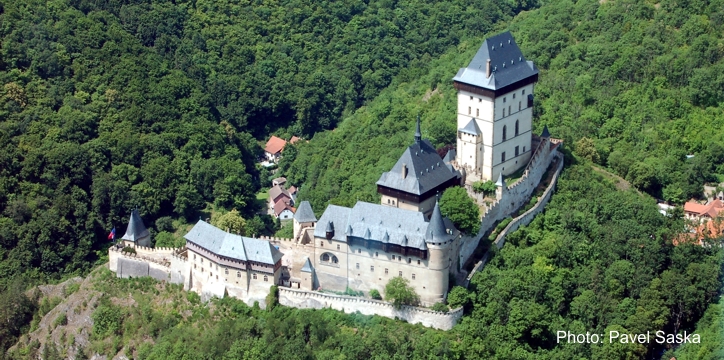A range of options is available for spending more days in Prague and the surrounding countryside before or after the meeting.
Post-meeting tour
As usual after the Symposium, a post-meeting tour will be arranged for participants of the meeting for the weekend following the Symposium (September 28-29, 2013). This time we will visit two different scenic areas.
1 – “Kokořínsko” Landscape Protected Area. This area is located north from Prague and is typical with sandstone rocks and towers, narrow curved valleys and small artificial caves made by local people during centuries. We will visit two different places: “Pokličky” in the central part of the area and the vicinity of “Čap” in the north-west part of the area. We will make two small hikes of moderate difficulty, altogether ca. 15 km long. “Pokličky” (Tea Tables in English) represent unique examples of sedimentary rock columns with the top layers being wider than the base due to greater resistance to erosion and weathering. “Čap” is notable rock pilot on the top of the eponymous hill. In the vicinity of Čap there is a number of prominent rock formations, and pine forest taken out of management. Good hiking boots and other equipment is necessary as the route will include short but steep ascends and descends in slippery terrain.
Day 2 – “Český Kras” Landscape Protected Area is located south-west from Prague and represents the most important karst area in Bohemia. It is rich for calcareous xerothermous steppes and forests, limestone rock formations and caves. We will start our trip by visiting the Karlštejn Castle, the famous castle of the famous king and Emperor Charles IV. This castle is absolute must of your visit of the Czech Republic. From there we will explore the area on foot (ca.12 km of easy walk), and we will close our excursion in the Koněprusy Cave, where you will see the magnificent example of dripstone formations. The spectacular “Koněprusy Roses” cannot be found anywhere else in the world (calcium carbonate dissolved in water, which then gradually precipitated on the walls of the underground lake in the shape of bushes, the tips of which later fell away to create an unusual formation reminiscent of rose blooms).
Both days we will leave the hotel in the morning and come back to Prague in the late afternoon or in the evening, so you can stay in the same hotel over the weekend. The price of the post-meeting tour is 65 EUR/ 1625 CZK and includes transportation (bus), entrance fees to Karlštejn Castle and Koněprusy Cave with guide, and two lunch packages.
“IBM”
The Immature Beetles Meeting (IBM) is an informal international entomological meeting that has established in the agenda of most researchers that are interested in all aspects of research on beetle larvae, including morphology, systematics or biology/ecology. It is usually visited by ca. 30-40 participants from all over the world, and the participants include both students and legends in the field of the coleopteran larvae research. It is organized jointly by colleagues from Charles University, National Museum and Crop Research Institute biannually. In 2013, the 5th meeting will take place one week after the ECM, on October 3-4 at the Charles University. Participants of the ECM will be warmly welcome to join the IBM. Importantly, there is NO conference FEE! More information about the forthcoming and past meetings can be found here: http://www.immaturebeetles.eu/.
International Insect Fare
The Prague International Insect Fare is a re-known event when collectors and insect specialists from the remote parts of the world meet and exchange, buy and sell their insect samples. In autumn 2013, it will take place on October 5-6.
Entomological Department of the National Museum
Department of Entomology of the National Museum, Prague, was established thanks to Jan Obenberger in 1920 as entomological section of the Department of Zoology and became separate department in 1952. Since 1961 the department resides in Kunratice castle in Prague. The origin of the entomological collections of the National Museum dates back to first half of 19th century and include, e.g. collection of the famous Czech travellers Jan Vilém Helfer from Burma and Emil Holub from South Africa. The collections are have been systematically buitl based on legacies and purchases from Czech entomologists as well as by field collecting by the staff of the department both in the Czech Republic and abroad. Traditionally, large collecting efforts were paid to the Balkan Peninsula. Later, important expeditions were organized toTurkey in 1947 and Iran in 1970, 1973 and 1977, resulting in the world largest collection of Iranian insects. Recently the collection includes about six millions of specimens from all regions of the world. Coleoptera and Lepidoptera are the most numerous groups within the collection, but in the last decades, attention was paid also to other groups (Hemiptera, Hymenoptera, Trichoptera, Diptera).
The collection of Carabidae represents one of the most important parts of Coleoptera section. It contains approximately 250.000 specimens. The oldest material is the collecting of J.V. Helfer in India and Tenasserim, subsequently processed by H.M. Schmidt-Göbel. The extensive material from Balkan Peninsula was worked out by former head of the department J. Mařan. The collections of J. Půlpán, M. Dvořák or K. Hůrka should be mentioned as the most recently gained specialised carabid collections in our museum. Separately, there is a large collection of A. Jedlička, which contains hundreds of types of Palaearctic and Oriental species, described mostly by Jedlička himself.
Unfortunately, due to lack of space and preparing of department for moving to new building (2013-2014), the collection is currently not optimally arranged and accessible. If you are interested you can still visit the collections during or after the 16th ECM. Just contact the head of the department Dr. Jiří Hájek: jiri_hajek@nm.cz.

